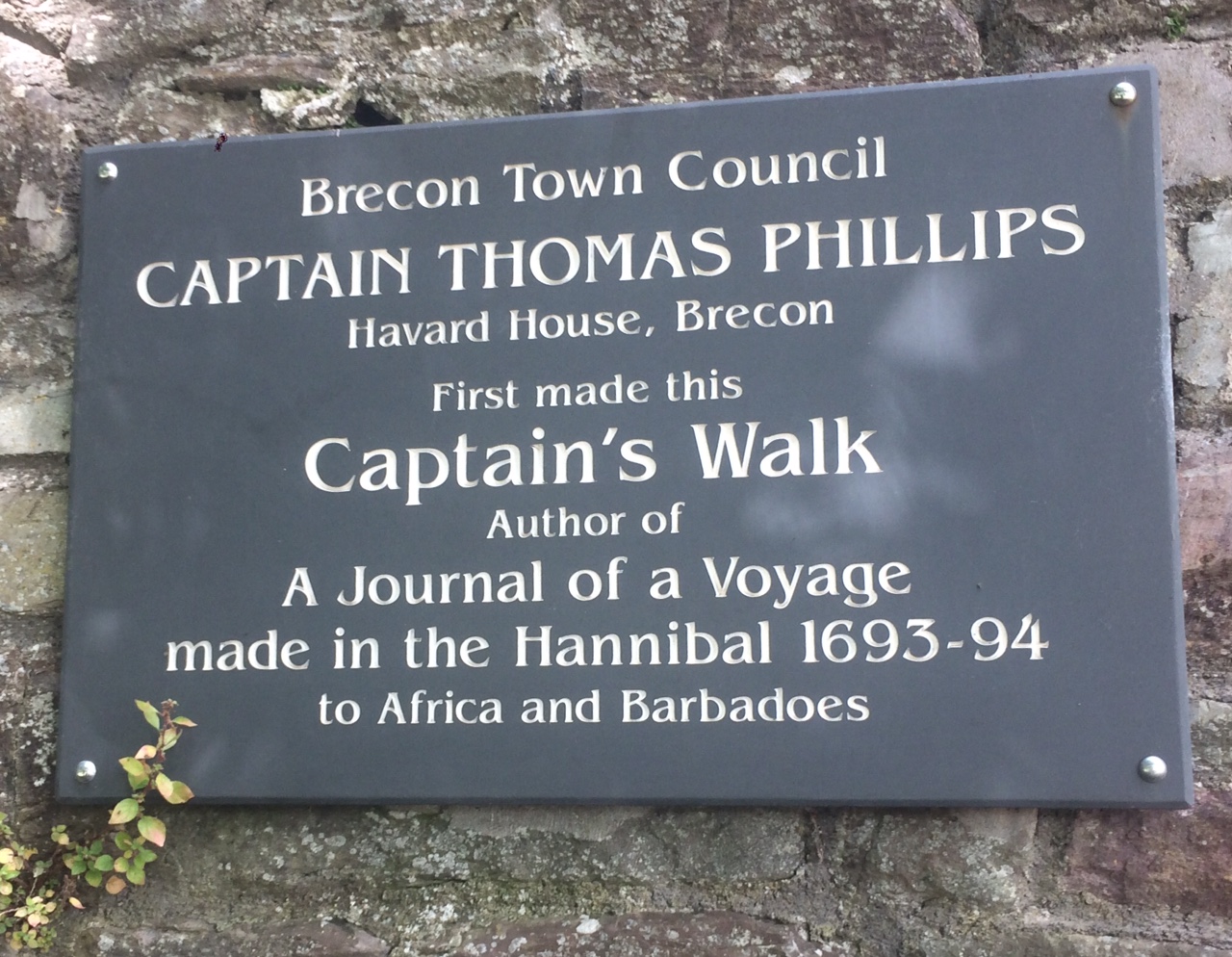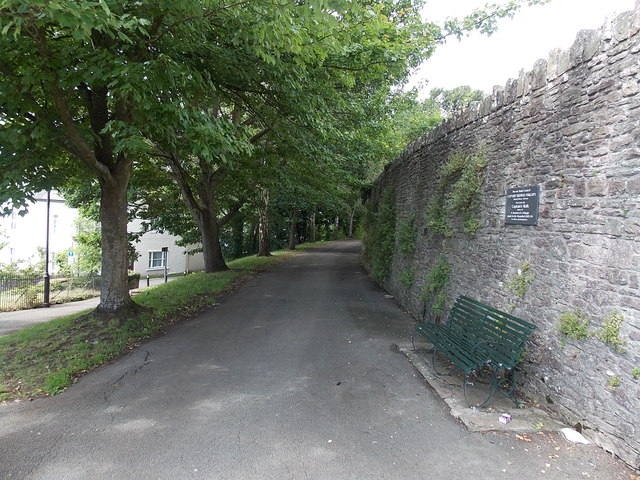
If you were to walk around the rear side of the former house and home of Captain Thomas Phillips in Brecon, located along Captains Walk, you will notice a rather handsome slate plaque memorialising his life. The Phillips’ family house is now St Ursula’s Convent, a former catholic school. The plaque was paid for by the people of Brecon, and was erected (though not without controversy[ 1 ]), in 2010. It reads innocently enough:
Havard House, Brecon
First made this Captain’s Walk
Author of
A Journal of a Voyage
Made in the Hannibal 1693-94
To Africa and Barbadoes
The plaque has a glaring omission in the chosen inscription at the time of its conception. Fast forward eight years later, and, in what should be more enlightened times, we still find a memorial in situ that fails to mention a sincere interpretation of the life and barbarous activities of Captain Thomas Phillips.
Phillips, at the age of 29 years and on his second voyage, became the captain of the infamous slave ship the Hannibal. Under his command he was directly responsible for the tragic deaths of 328 (47 per cent) of the 700 enslaved African women, men and children on board, along with 18 of his crew of 70. A very large number of people died in the cruellest of ways, people who would still have been in shock having being stolen from their families, homes and culture.[ 2 ]
Let me be frank about the sort of man Captain Phillips was. Before boarding the Hannibal the male slaves were cuffed to one another in irons, and in pairs at their wrists and legs to prevent rebellion and to avoid the enslaved attempting to jump overboard and escape. (Phillips writes in his journal of how men who jumped overboard would then be eaten by the many sharks that swam in the shallows). Phillips also states in his journal that before boarding the ship all the slaves, including around 50 children, would be branded on the chest with a small capital “H” to claim them for the Hannibal. Phillips writes in his journal that the branding left a white mark and ‘generally’ healed up within 4 to 5 days because of their ‘applying palm oil before hand to smooth the wound’. This effectively meant they were in fact frying human skin and guilty of torturing their captives, including the children. Phillips knew that his activities were immoral, even in the era of the late seventeenth century, as he wrestled with his conscience whilst writing his journal.[ 3 ]
Phillips had a 10 per cent financial stake in the ship. His patron Sir Jeffrey Jeffreys [ 4 ], a wealthy slave trading West India merchant and manager in the Royal African Company, personally chose Phillips to be commander of the Hannibal. The vessel had been converted into a slave ship from a previous frigate under the observance of Phillips in person. This meant the fitting of small cramped lower decks where the slaves would be shackled for most of the voyage, without enough room to sit up right. Phillips was now deeply involved in the slave trade, in which he had hoped to make a great deal of personal wealth by selling his tortured and humiliated human cargo. Their suffering was of little or no consequence to Phillips. In his journal he appears to attempt to offer a sort of reasoning to justify his cruelty, this being based on the fact that black slaves were heathens and as such were a lower caste that Christian people. One cannot help but notice the irony that this plaque in Brecon was dedicated by an elderly nun and local historian from St Ursula’s Convent, who was fully aware that Phillips was a slaver.
The Hannibal was part of the merchant fleet of the Royal African Company and sailed the very profitable triangular trade route. Goods were transported down to the west coast of Africa, including in this case cloth made in Brecon, iron bars and other such useful goods that could be bartered in order to trade with African chiefs for elephant’s teeth (tusks), gold dust and enslaved Africans. The ship was then to sail west, across the Atlantic to the West Indies and the British owned island of Barbados. The slaves would be sold onto waiting plantation owners. The return trip back to England would involve carrying a cargo of tobacco, sugar, spices and other valuable slave-produced commodities, including in the case of the Hannibal two chests of gold from the sale of African people.
When the ship arrived in the ‘New World’ in November 1694, only 372 enslaved Africans out of an original number of 700 remained alive on board. Horrifically 328 women men and children had died while in transit. Some had succumbed to an outbreak of dysentery and smallpox because of the dreadful conditions on board, while others had perished jumping overboard out of terror. It is even alleged that some of the slaves, including women, were dumped overboard by the crew while still alive, as had happened previously on other slave ships. This murderous crime was committed in order that insurance claims money – for loss of goods in transit – could be collected to assure a reprehensible trade was still profitable because the slave traders only received payment for the slaves (‘cargo’) who were delivered alive. A young male slave could be insured for £30 and they were considered ‘cargo’. Phillips told an inquiry about twelve of the slaves: “We had about 12 negroes who did wilfully drowned themselves during the voyage and others persistently refused food, starving themselves to death”.[ 5 ]

We need to consider who the plaque is for. For example, is the memorial for the towns’ people to enjoy? Or, perhaps it was erected as a signage marker for tourists? Is the plaque to act as an elegant landmark to gentrify the town of Brecon along the Captains Walk trail? Can it be that the honouring of Captain Phillips is meant to educate the children who come across his name that the town has produced quite a few famous seafarers? Perhaps the plaque is a mixture of all of the above. Disappointingly the plaque fails to mention that Captain Thomas Phillips was a slave trader which is a serious inadequacy considering that this is the only fact that characterises Phillips as a notable in history. That is, other than the fact that, few slave-ship captains had presided over such catastrophic suffering and loss of life in a single voyage.
The persons, our civic leaders, who decide who and what should be commemorated need to consider that they are forming the foundations of a collective memory and this is why it is so important that people in history are remembered with integrity and directness. Without this consideration we are as a society guilty of a social construct that is inauthentic, and therefore might be construed as social propaganda. Memorials are about not only commemorating the great and good, but also areas of our nation’s history that are sad and notable for previous acts of violence that are condemned today, because our interpretation of history evolves as societies attitudes toward our fellow humans change and our awareness about the true facts of history are widely available.
The social construct of memorialisation is very powerful and therefore our elected and non-elected representatives have a duty – a civic responsibility – to interpret our nation’s history with integrity and openness. Some would argue that monuments represent an ideology imposed on our collective landscapes which may give a false interpretation of a privileged heritage, and therefore an elitist interpretation of our history. If this is the case then it can also equally be argued that we need to open up our interpretations of our collective history, by bringing a challenge of rectitude for all our communities during the 21st century. It is a huge responsibility on the part of local officials to decide who they will choose to commemorate in our towns and parks and in which style of iconography would best serve the history of our nation.
The plaque memorialising this seafaring captain had a glaring omission at the time of its conception and eight years later, and in what should be more enlightened times, we still have a memorial that very controversially fails to convey a sincere interpretation of the life and barbarous activities of a previous inhabitant of Brecon, who remains part of our collective past; that of Captain Thomas Phillips, Slave Trader. Not something to commemorate though is it really?
- [ 1 ] See the article on Wales Online “Slave trader plaque sparks row” 9 October, 2010. Accessed August 2018: https://www.walesonline.co.uk/news/wales-news/slave-trader-plaque-sparks-row-1890358 [back…]
- [ 2 ] The Trans-Atlantic Slave Trade Database, http://www.slavevoyages.org (accessed August, 2018). [back…]
- [ 3 ] Phillips T. A Journal of a Voyage made in the Hannibal of London, Ann. 1693, 1694, From England to Cape Monseradoe, in Africa, and thence along the Coast of Guiney to Whidaw, the Island of St. Thomas, and so forward to Barbadoes. With a Cursory Account of the Country, the People, their Manners, Forts, Trade, etc. p.3. Published by Churchill 1732, within a Collection of Voyages and Travels. Vol.I. [back…]
- [ 4 ] Jeffreys purchased Brecon Priory estate and became a town councillor and MP for Brecon in 1690, holding the position for the majority of the next two decades. Hayton, D. W. “ JEFFREYS, Jeffrey (c.1652-1709), of St. Mary Axe, London and The Priory, Brecon” in D. Hayton, E. Cruickshanks, S. Handley (Eds) The History of Parliament: the House of Commons 1690-1715 . (London: Boydell and Brewer, 2002) [back…]
- [ 5 ] Murdoch S. “John Brown: A Black female Soldier in the Royal African Company”. World History Connected. Vol.1, iss. 2. p. 4 [back…]





Hi Rosemary,
Thanks for writing this article in 2018.
I was born and brought up in Brecon and know Captain’s Walk, but I never had any idea that it was named after a real person, let alone someone involved in the slave trade.
In 2010, when the plaque was unveiled a Brecon Town Council spokesman said, “The environment committee of this town council is not commemorating Captain Thomas Phillips’ 12-month period as a commander of a slave ship.
“We are commemorating the fact that in his journal of his voyage written in the 1690s, he was one of the first recorded persons of his time to make such liberal remarks on race when he wrote,
‘I cannot imagine why they should be despised for their colour seeing what they cannot help and the effect of the climate God has given them. I cannot think there is any basic value in one colour more than another, nor that white is better than black, only we think so because we are so.’
In light of the information in your article I think that it’s right that the plaque has been taken down. I think there should be a plaque, but it should tell a more complete story with due weight given to the horrors of the slave trade. Kids growing up in Brecon should be taught that there was a slave trade and that even in rural mid Wales we were part of it.
The ripples created by George Floyd’s death have indeed travelled far.